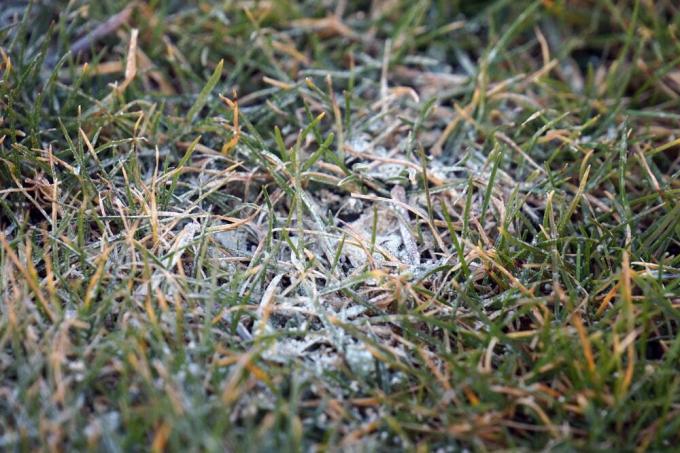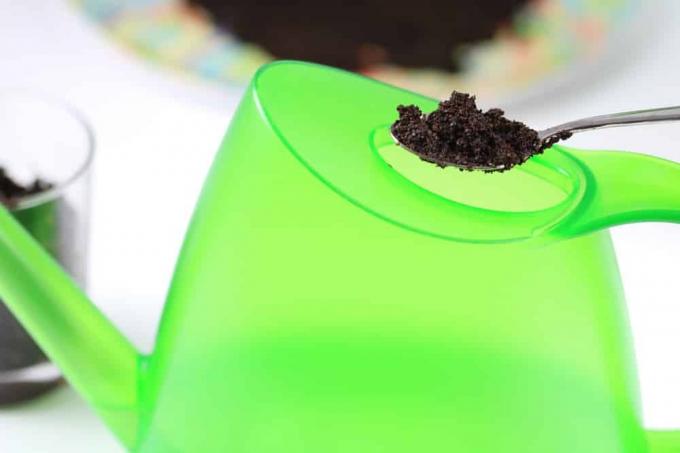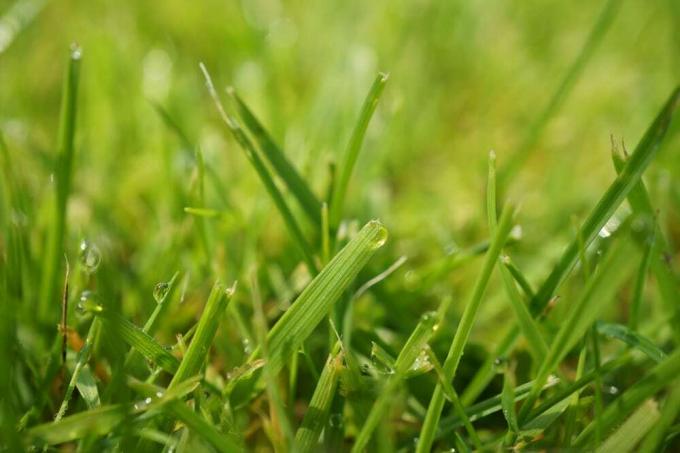

Table of contents
- Nutrients in lawn fertilizer
- Nitrogen
- phosphate
- potassium
- magnesium
- iron
- calcium
- Organic or mineral fertilizers?
- Special additives for soil pH
- weed killer
- Combination products of lawn fertilizer and weed killer
- Conclusion
- Tips for speed readers
By caring for your lawn, fertilizing and removing the weeds, you create significantly better living conditions for the tender grasses. However, in order to have a healthy and beautiful lawn in the garden in the long term, a few more measures are necessary. However, a good start is already made with a suitable lawn fertilizer against weeds and moss. On the one hand, fertilizer strengthens the lawn, on the other hand, it creates unfavorable conditions for weeds. In the case of strong weed growth, a suitable weed killer in the fertilizer can also help to combat it.
Nutrients in lawn fertilizer
Unfortunately, the weeds in the lawn are much more difficult to remove than in the bed. Many gardeners therefore quickly resort to a lawn fertilizer. The choice isn't too bad, because where the grass is resilient and strong, weeds have fewer chances. The most common reason for heavy weed and moss growth in the lawn is and remains a pronounced lack of nutrients. In contrast to lawns, weeds require very few nutrients. Lawns require a special fertilizer with a high nitrogen content. Phosphorus and potassium are also important. There is also a need for calcium, magnesium, iron and trace elements for healthy growth.
Nitrogen
Ornamental lawns require high levels of nitrogen in order to grow well. Nitrogen ensures green foliage, new growth of the shoots and thus a denser spread of the lawn. Therefore, a good lawn fertilizer should contain a high proportion of nitrogen. However, an oversupply quickly leads to burns.
phosphate
Phosphate not only promotes root growth, but is also an energy source for the lawn and microorganisms in the soil. Through the formation of new roots, the grass is better anchored in the soil and can absorb other nutrients more optimally. With a dense root system, the lawn can store water better. Plants that are sufficiently supplied with phosphate are more frost-resistant than undersupplied grasses and develop much faster after a long and cold winter.
An oversupply of phosphate is very harmful as it raises the pH level. Therefore, phosphate should be used sparingly. The nitrogen/phosphorus ratio should not be less than 3:1 (e.g. 10% N and 3% P or 15% N plus 5% P).
Tip:
The phosphate content can be deduced from the soil pH value: the lower (more acidic) the pH value in the garden soil, the fewer phosphates it contains.
potassium
The potassium ensures that the grass can store the cell fluid well. In this way, the plants survive frosty temperatures in winter better. In order to make the lawn winter-proof, the last fertilization should be done in autumn with a potassium-rich fertilizer. If the lawn lacks potassium, it becomes susceptible to diseases over the winter months, which is noticeable, for example, in yellowish discolouration. Since potassium also protects against dehydration, the June fertilization should also contain a little more potassium.
Tip:
Potassium is often found in lawn fertilizers in the form of poorly soluble potassium silicate. Since potassium silicate can only be converted by the grass plants in small amounts, it is necessary in this case to additionally fertilize with pure potash fertilizer.
magnesium
Plants only need traces of magnesium, so it should only be introduced in small amounts via lawn fertilizer. Although the proportion of magnesium is only in the smallest parts per thousand range, the lawn cannot grow without the mineral. Magnesium is necessary for the formation of chlorophyll, which the plant needs for photosynthesis. Magnesium therefore ensures a healthy leaf green as a sign of a high proportion of chlorophyll in the leaves of the lawn.
iron
If there is a high proportion of moss, an additional iron fertilizer will help. Iron is also an important nutrient (i.e. fertilizer) for the lawn and a natural moss killer. Most iron fertilizers are iron sulphate. The remedy - used alone - has the disadvantage that it is not entirely harmless.
calcium
Calcium is also a trace element that the lawn only needs in the smallest concentrations to strengthen the cell walls and form the root hairs.
Organic or mineral fertilizers?

A distinction is made between mineral and organic fertilizers. As a rule, mineral fertilizers contain fast-acting nitrogen compounds in the form of nitrate and ammonium. These compounds are easily soluble in water, so an effect can be seen in just a few days. However, the mineral fertilizer is also washed out more quickly by rainwater and is then no longer available after a short time. Organic fertilizers, on the other hand, contain nitrogen compounds that must first be broken down by soil organisms. The effect is weaker here, but lasts longer (no risk of over-fertilization). Combinations of both types of fertilizer are therefore best suited to ensure a sufficient supply of nitrogen over the entire growing season.
Special additives for soil pH
Where there are a lot of weeds growing in the lawn, the soil may be very sandy or compacted. Both conditions are not optimal for the growth of the lawn and should be improved by appropriate measures. But the pH value in the soil also has a major influence on lawn growth and the occurrence of moss and weeds in the lawn. It is therefore worth checking the pH value in the garden soil. This can be done quickly and easily with a quick test that is available in garden centers, pharmacies or online shops. If the pH value is too acidic (well below 6), this promotes the growth conditions for mosses. In this case, in addition to soil improvement measures, lawn lime or a special soil activator that neutralizes the acid also helps. Lime should no longer be applied from a pH value of around 6.5. Whether the soil is basic or acidic can often be seen from the vegetation:
- Moss indicates acidic soil
- Clover tends to grow in alkaline soil
Tip:
Be careful if the soil pH value increases too much! Nutrients such as iron can no longer be absorbed in neutral or alkaline soils (pH values well above 6) because they are in a water-insoluble form.
weed killer
Anyone who uses weed killers in the lawn must make sure that they are also suitable for use on lawns. Many weed killers (total weed killers, Roundup products) kill everything: weeds, moss - and lawn! When treating lawns, only so-called lawn weed killers may be used. These agents can "distinguish" between lawn and weeds. Lawn weed killers usually contain various active ingredients:
- nature-identical active ingredients
- chemical agents
- synthetic (reproduced) plant hormones
- many contain so-called growth substances
- trigger uncontrolled growth in all dicotyledonous plants
- no effect on monocots (like lawn)
- Lawn weeds are usually dicotyledonous plants
- eventually leads to the death of the weeds
- most remedies contain two to four different active ingredients
Combination products of lawn fertilizer and weed killer
While pure lawn weed killers are usually applied to the lawn in liquid form, there are also combination products of lawn fertilizer and weed killers on the market. These are available in granular form and can be sprinkled onto the lawn. Although these products are particularly easy to use, the weed killer does not work quite as reliably as with a liquid preparation. The effect of a weed killer depends heavily on the right preparation, application and weather conditions. Best conditions for effectiveness:
- warm day (no hot temperatures, but also no cold)
- mild night (no frosts)
- wet ground
- do not apply to freshly mowed lawns
- Time: late afternoon
- plants that are easy to fight: dandelion, white clover, daisies, plantain
- Most of the remedies only have a limited effect on: speedwell, buttercup plants, wood sorrel and ground ivy
Tip:
Despite the broad effect, not all types of weed can be controlled with all lawn weed killers. Therefore, check in advance which types of weeds are present and seek advice from specialist retailers.
Conclusion
If site conditions and soil quality are not optimal, suitable lawn fertilizers can strengthen the lawn and make life more difficult for weeds. If the lawn has been pushed back by weeds, a combination product with a weed killer makes sense instead of pure lawn fertilizer. In addition to nitrogen (both in mineral and organic form), a good lawn fertilizer contains a small proportion of phosphorus and the trace elements iron, magnesium and calcium. In autumn, the lawn fertilizer should be high in potassium.
Tips for speed readers
- not all fertilizers are suitable for lawns
- pay attention to the right composition of the fertilizer
- high nitrogen levels and moderate phosphorus levels
- Combined fertilizers made from mineral and organic fertilizers are best suited
- Potassium (especially in autumn)
- Trace elements such as magnesium and calcium
- Iron vs Moss
- Measure pH and adjust if necessary (optimal 6-6.5)
- pure ornamental lawn: one fertilization in April, one in June
- Contaminated lawn: another fertilization in autumn (potassium emphasized)
- March to April: first fertilization depending on the weather
- start weed control
- June: second fertilization (maintenance fertilization)
- July and August: do not fertilize (too warm and dry)
- September to October: Potassium stressed fertilizer
- November to February: no fertilization
 garden editorial
garden editorial I write about everything that interests me in my garden.
Learn more about fertilizer

Lawn lime: Lime against moss in the lawn
As soon as moss appears in the lawn, many a hobby gardener becomes restless - because soon the moss carpet can take over entire areas. With lawn lime, however, the unwelcome visitor can be skilfully put in his place.

Build your own Bokashi bucket | DIY instructions
Most of the kitchen waste goes on the compost or in the organic bin to add it back to nature's cycle. But there is a way to gain valuable fertilizer beforehand. We show how easy it is to build a Bokashi bucket and use it to obtain liquid fertilizer on the balcony or even in the apartment.

These 8 plants don't like coffee grounds as fertilizer
Hobby gardeners swear by the effect of the coffee grounds. It is fertilizer, snail protection, soil conditioner and cat deterrent all at the same time. In addition, it is free of charge and occurs daily in the household. Most plants are strengthened, but some are sensitive to the addition of coffee. We clarify.

Fertilize Christmas roses properly: 11 effective home remedies
Christmas roses are special flowers because, unlike almost all other perennials, they bloom in winter. They are insensitive and frost-hardy, and they can also multiply independently. Here you can find out what needs to be considered when fertilizing.

Lawn Bokashi: 6 steps to a cheap & natural fertilizer
The name Bokashi is still largely unknown. This method of using grass clippings comes from Japan. With a little preparation and a special form of processing, the clippings become valuable, nutrient-rich fertilizer that can be easily distributed in the garden.

Wood ash as fertilizer | These 70 plants love barbecue and charcoal
Home gardeners with a fireplace or tiled stove receive a natural fertilizer for free. Charcoal and charcoal leave behind a dusty residue that is packed with valuable nutrients. Read here under what conditions wood ash is suitable as a fertilizer. These 70 plants benefit from the unorthodox nutrient supply.



